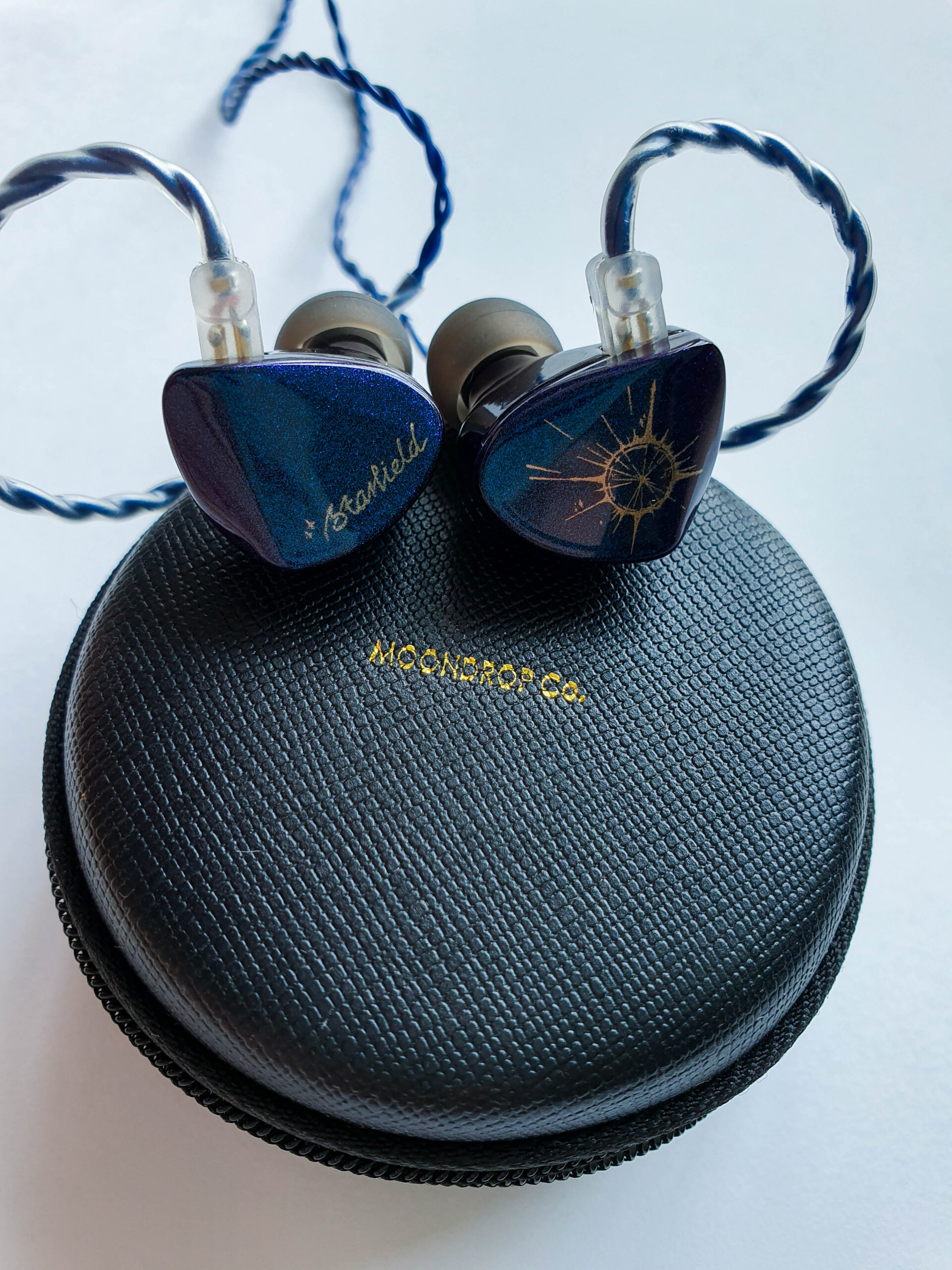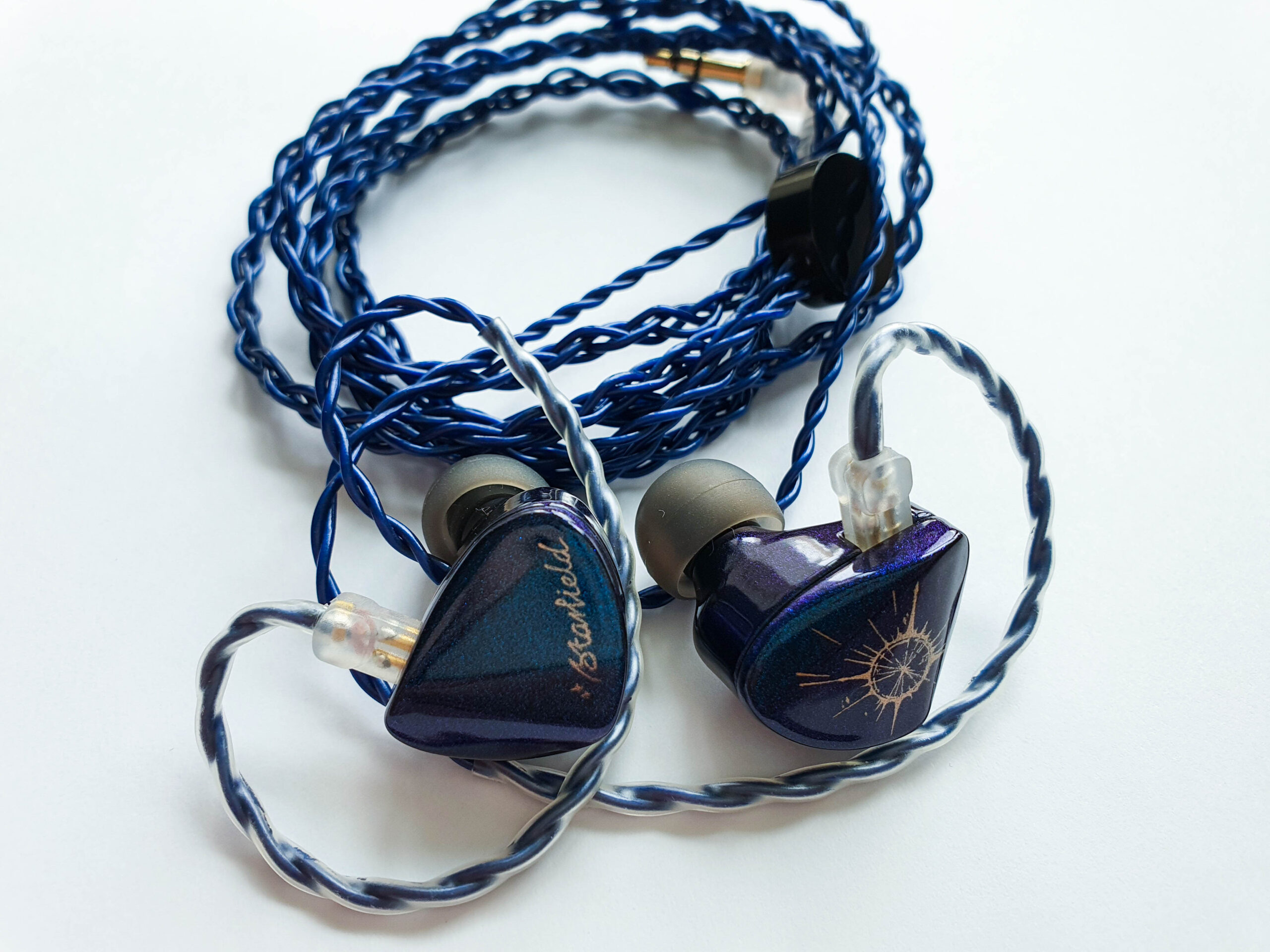Updated: Nov 19, 2020
Pros: Luxuriously smooth across spectrums, Impressive sub-bass and treble extension, Nice soundstage, A flagship IEM tuning minus the flagship price.
Cons: Paint chips easily, Barebones accessories and fragile cable, Bass can get a little muddy due to slow decay
Driver Setup: Single Carbon Nanotube (CNT) Dynamic Driver
Price: $109 (USD)
Intro
Disclaimer: I borrowed the Moondrop Starfield from mistereden on Carousell Singapore for review purposes. It currently retails for $149.90 (SGD).
This is a review of the Moondrop Starfield, a single dynamic driver earphone from the company who brought us the Kanas Pro, Blessing and A8 among many other great offerings. The Starfield has quickly become one of the most popular recommendations in the $100 – $200 price range and we shall explore why that is the case today.
Packaging and Accessories (Score: 6.5/10)
Minimal packaging but still not lacking in quality in any way. Moondrop’s minimalistic approach still carries a certain classy vibe. The black zippered case, although a little on the small side, feels very sturdy and well-made. I really like the black gold colour scheme with a small gold imprinted branding on it. Almost looks like a brand name item.
It also comes with tweezers and replacement mesh filters and the stock ear tips which are quite comfortable. Overall, nothing to scream about but nothing much to complain about.

Build Quality and Fit (Score: 7/10)
Build quality of the earpieces are great. It uses the same zinc-aluminium alloy for the shells which feels quite weighty in the hand. Although significantly heavier than typical plastic shell IEMs, these still fit very nicely in the ear. It has good balance and doesn’t threaten to fall out of the ear. Although these may not be the most comfortable earphones for anything more than a stroll outside.

Although the Starfields look so pretty thanks to its unique glittering paint job, it does not seem to be very durable. It’s been said that they can chip from just the IEMs knocking against each other and it’s a real shame.
The cable is really soft in the hands and comes in a matching dark blue. Although Moondrop has been quite proud of the technical specs of the cable, I would say it doesn’t exactly inspire confidence just looking at it.
Sound (Overall Score: 8.3/10)
Sources Used
- Shanling M3s
Albums and Tracks Listened to
- Postmodern Jukebox (PMJ) – Jazz me Outside Part. 1
- Postmodern Jukebox – The New Classics (Recorded Live!)
- La La Land Original Motion Picture Soundtrack
- The Temptations – Classic Soul Hits
- Noah Kahan – Busyhead
- Mozart Clarinet Concerto in A Major, K.622 by Martin Frost
Bass (Score: 7.5/10)
The sub-bass extension is very good and is probably the best thing about the bass. The bassline on The Temptations’ “How Sweet It Is” sounded really satisfying with the nice rumble in the lower bass. There is an overall emphasis on the bass and lends to the overall warmth of the sound.
However, I find the decay a little too slow for my liking and at times muddies the tracks. I prefer quicker bass with more bite while the Starfield has it more rounded, however, this may be a matter of preference. Listening to PMJ’s “All About That Bass”, when it hits the double bass solo, I didn’t really enjoy the texture of the double bass plucks as I usually would, and I wish kick drums had more bite and punch.
Mids (Score: 8.5/10)
Mids are very smooth and I would say the main difference between the Moondrop KXXS and the Starfields lie here. It’s more of a matter of preference in this area but Moondrop has smoothened out the peaks in the upper treble and now female vocals are less forward. People who shied away from the KXXS because they found the upper mids shouty would rejoice. Personally, I preferred the energy of the vocals in the KXXS, but the differences aren’t that huge, and I still find both enjoyable.
Listening to PMJ’s “Perfect Duet”, I didn’t have any problems when it got to the saxophone solo. It usually gets a little bit overbearing to listen to and have to turn the volume down on earphones with peaks in the upper mids and treble. However, on the Starfields the solo remained controlled yet soulful, with plenty of air to it and avoided all harshness.
The lower mids of the Starfield have plenty of body to them and possess a certain mellow sound to them. I really enjoyed listening to the A Clarinet in the Martin Frost’s rendition of the Clarinet Concerto in A. The clarinet solos were very full-bodied, smooth and the instrument tonalities were all spot on.
Treble (Score: 8/10)
There is significant airiness in the treble and it never comes across harsh or cold. Bells and crash cymbals have a very nice timbre and sparkle to them and complement the overall warmth of the Starfield’s tuning. I had absolutely no problems with sibilance and it’s something you almost never get on the Starfields. On top of this, the treble extension is very impressive and doesn’t compromise on the microdetails.
Overall
The Starfields have quite a big soundstage and the expansive sound adds a certain luxurious feel to the sound signature. I would say this Harman tuning is very mature and is one that is sure to be enjoyed by many. There are technicalities that can be improved in the bass region but the Starfields really don’t deserve my nitpicking at this price point.
Comparison
Moondrop Starfield ($150) vs. Moondrop KXXS ($250)

The Moondrop KXXS (Review Here)
The differences between the two… start and end at the extravagant unboxing experience of the KXXS which the Starfields miss out on.
Okay, I’m kidding, partly. Apart from the fact that the Starfield comes in the blue paint job, the shells are identical and made of the same sturdy metal alloy. They both too have the same sound signature and you wouldn’t be able to tell them apart unless you have been listening to both for a while.
To me, the differences lie mostly in the upper mids and how forwards the vocals (especially the female vocals). Although I did say I prefer the slight edginess of the KXXS more. It does give a more refined sound profile where certain tracks like vocal tracks have more room to shine.
Having owned the Moondrop KXXS before getting my hands on the Starfield, I was puzzled at the release of such a similar looking IEM with a similar single dynamic driver set up. And this feeling slowly grew into bewilderment and disbelief when the Starfield sound almost like a sidegrade. How was Moondrop going to justify the difference in price between the two models? (The miniature plastic anime-girl figurine that comes with the KXXS isn’t going to cut it for me)
It becomes nearly impossible to recommend the KXXS with the Starfield around. Although the Starfield does have a poorer cable and an inferior paint job, everything else about the Starfield just almost makes the KXXS obsolete.
Conclusion
Moondrop went with the “if it ain’t broke, don’t fix it” approach on the Starfields with a continuation of the Harman target tuning. Some may see the smoothening of the upper mids as a “fix” to the KXXS. The overall sound of the Starfield is a somewhat “premium” sound minus the premium price tag. I can see this tuning being very popular and is one that you can listen to for hours on end without fatigue, whether you’re gaming, listening to audiobooks or just listening to music. These will be a fan favourite for a long time, especially if you’re a fan of Moondrop’s take on the Harman tuning. Once again, Moondrop has outdone themselves and raised the bar for a capable and yet musical single dynamic driver IEM and this is now the new benchmark to beat.
Click HERE for our grading list for earphones
